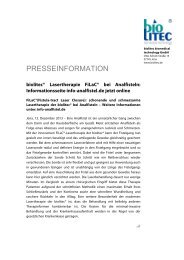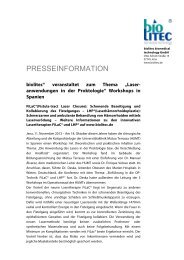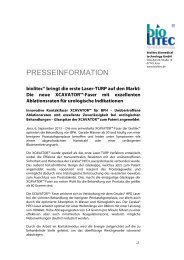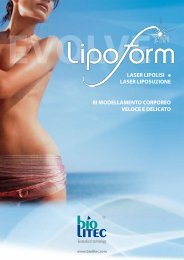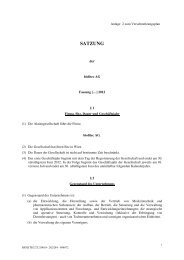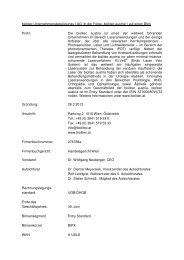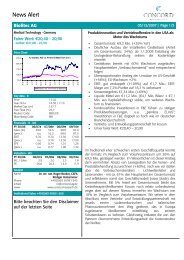Application of the biolitec EVOLVE Laser in interconventional ...
Application of the biolitec EVOLVE Laser in interconventional ...
Application of the biolitec EVOLVE Laser in interconventional ...
You also want an ePaper? Increase the reach of your titles
YUMPU automatically turns print PDFs into web optimized ePapers that Google loves.
<strong>Application</strong> <strong>of</strong> <strong>the</strong> <strong>biolitec</strong> <strong>EVOLVE</strong> <strong>Laser</strong> <strong>in</strong> <strong>in</strong>terconventional bronchology<br />
The implementation <strong>of</strong> different new techniques <strong>in</strong> <strong>the</strong>rapeutic bronchoscopy led to a<br />
reduction <strong>in</strong> morbidity and mortality <strong>of</strong> critically ill patients. With<strong>in</strong> <strong>the</strong> palliative approach<br />
with a central malign obstruction <strong>Laser</strong> resection, Electro‐Kauter or <strong>the</strong> Elector coagulation,<br />
Argonplasmabeamer, <strong>the</strong> (“new”) Kryo‐Recanalisation as well as airway‐stent<strong>in</strong>g <strong>in</strong> some<br />
cases <strong>of</strong>fer chances for an immediate reduction <strong>of</strong> <strong>the</strong> symptoms. Classical cryo<strong>the</strong>rapy,<br />
brachy<strong>the</strong>rapy and photodynamic <strong>the</strong>rapy mostly only have an effect when adopted with<br />
latency.<br />
Cl<strong>in</strong>ical background<br />
Advanced bronchial carc<strong>in</strong>omas <strong>of</strong>ten lead to a massive limitation <strong>of</strong> <strong>the</strong> quality <strong>of</strong> life<br />
because <strong>of</strong> an <strong>in</strong>creased local tumor size. A significant obstruction <strong>of</strong> <strong>the</strong> central respiratory<br />
system with serious symptoms requires quick <strong>the</strong>rapeutic measurements with an immediate<br />
rebuild<strong>in</strong>g <strong>of</strong> <strong>the</strong> airway passage. The central airway obstruction is based on <strong>in</strong>tralum<strong>in</strong>al<br />
tumor growth, extralum<strong>in</strong>al compression or – <strong>in</strong> many cases – on a comb<strong>in</strong>ation <strong>of</strong> both.<br />
Most <strong>of</strong>ten <strong>the</strong> relocation <strong>of</strong> <strong>the</strong> airway exists <strong>in</strong> advanced cases where <strong>the</strong>rapies like<br />
chemo<strong>the</strong>rapy and radiatio cannot be applied successfully anymore. The approved<br />
<strong>the</strong>rapeutic strategy conta<strong>in</strong>s tumor coagulation <strong>in</strong> order to reduce <strong>the</strong> risk <strong>of</strong> bleed<strong>in</strong>g,<br />
followed by – if possible – mechanical ablation and – if after that <strong>the</strong>re is still significant<br />
compression – <strong>the</strong> <strong>in</strong>sert <strong>of</strong> a stent.<br />
<strong>Laser</strong>‐resection<br />
<strong>Laser</strong>‐resection is understood as <strong>the</strong> application <strong>of</strong> laser energy through a fixed and/ or<br />
flexible bronchoscope <strong>in</strong> order to treat endolum<strong>in</strong>al lesions <strong>in</strong> a curative or palliative way.<br />
The term <strong>Laser</strong> stands for “light amplification <strong>of</strong> stimulated emission <strong>of</strong> radiation”. The laser<br />
light is applied through optical fibers, which are appropriate for bronchoscopy. The impact <strong>of</strong><br />
<strong>the</strong> laser is characterized by: 1. power adjustment <strong>of</strong> <strong>the</strong> laser; 2. absorption and diffusion<br />
coefficient <strong>in</strong> <strong>the</strong> tissue; 3. <strong>the</strong> application system. The effect <strong>of</strong> <strong>the</strong> laser is <strong>in</strong>fluenced by<br />
laser type, tissue characteristics and application duration. Besides vaporization a laser which<br />
is suited for bronchoscopy allows a f<strong>in</strong>e coagulation <strong>of</strong> <strong>the</strong> tissue. Because <strong>of</strong> that <strong>the</strong><br />
Nd:YAG laser is used <strong>in</strong> bronchoscopy. Recently also o<strong>the</strong>r lasers like <strong>the</strong> diode laser are<br />
<strong>of</strong>fered and used by us. Normally, fibers for <strong>the</strong> use <strong>in</strong> contact mode and non‐contact<br />
procedure are <strong>of</strong>fered. Coagulation is achieved by a greater distance <strong>of</strong> <strong>the</strong> fiber to <strong>the</strong><br />
tissue, vaporization through a shorter distance to <strong>the</strong> tissue and through modifications <strong>of</strong><br />
<strong>the</strong> sett<strong>in</strong>gs. The selected tactic is dependent on <strong>the</strong> availability <strong>of</strong> fixed bronchoscopy. With<br />
<strong>the</strong> fixed or comb<strong>in</strong>ed procedure <strong>the</strong> tumor is coagulated at first and ablated mechanically<br />
with a fixed pipe under a reduced risk <strong>of</strong> bleed<strong>in</strong>g. The suction <strong>of</strong> <strong>the</strong> smoke via <strong>the</strong> fixed<br />
pipe is reasonable. The flexible procedure also coagulates; afterwards <strong>the</strong> tumor is ei<strong>the</strong>r<br />
vaporized totally or ablated mechanically with smaller <strong>in</strong>struments. Thereby <strong>of</strong> course <strong>the</strong><br />
procedure is limited. The laser‐resection requires a high quality anes<strong>the</strong>sia, with <strong>the</strong> flexible<br />
procedure mostly as local anes<strong>the</strong>tics with sedatives or general narcosis, with <strong>the</strong> fixed<br />
procedure normally as a general narcosis with muscle relaxation.<br />
‐ 1 ‐
Picture 1: Different<br />
laser typees,<br />
<strong>the</strong>ir waave<br />
lengths and <strong>the</strong> relation<br />
to thhe<br />
absorptio on curve<br />
<strong>of</strong> water<br />
and hemooglob<strong>in</strong>.<br />
Thee<br />
diode laseer<br />
applied has<br />
a wave leength<br />
<strong>of</strong> 14470nm.<br />
Cl<strong>in</strong>ical experiencee<br />
and resultts<br />
After thhe<br />
first laseer‐resectionn<br />
publicatioons<br />
<strong>in</strong> 1976 by Laforett<br />
et al. thiss<br />
become <strong>the</strong><br />
most<br />
commonly<br />
used noon‐chirurgiccal<br />
method for malign,<br />
semi‐malign<br />
or even benign diseases<br />
<strong>of</strong><br />
<strong>the</strong> enddolum<strong>in</strong>al<br />
reespiratory<br />
ssystem.<br />
Thee<br />
<strong>in</strong>dication n for laser‐resection<br />
exxists<br />
for obs structive<br />
lesions <strong>of</strong> <strong>the</strong> trachhea,<br />
<strong>of</strong> <strong>the</strong> ma<strong>in</strong> broncchia,<br />
<strong>of</strong> <strong>the</strong> bronchus <strong>in</strong>termediuss<br />
or <strong>of</strong> lobe orifices,<br />
which hhave<br />
a bad impact on ventilation or cause symptoms<br />
liike<br />
stridor, cough, hem moptysis<br />
or secreetion<br />
retention.<br />
The laaser<br />
<strong>the</strong>rappy<br />
for lesions<br />
which aare<br />
more <strong>in</strong>n<br />
<strong>the</strong> periph hery are<br />
<strong>in</strong>dicateed<br />
only exceptionally.<br />
<strong>Laser</strong> <strong>the</strong>erapy<br />
is most<br />
<strong>of</strong>ten used for <strong>in</strong>operable<br />
lung or<br />
bronchial<br />
carc<strong>in</strong>ommas<br />
with endolum<strong>in</strong>al<br />
manifestation<br />
for a palliative ppurpose.<br />
It is <strong>of</strong>ten<br />
comb<strong>in</strong>ed<br />
with othher<br />
types o<strong>of</strong><br />
treatmennt<br />
like exte ern exposurre,<br />
brachythherapy<br />
and/<br />
or <strong>the</strong><br />
applicattion<br />
<strong>of</strong> a steent.<br />
Contra<strong>in</strong>dications<br />
are mostlyy<br />
relative. The absenc ce <strong>of</strong> an <strong>in</strong>ntralum<strong>in</strong>all<br />
component<br />
is an<br />
absolute<br />
contra<strong>in</strong>ndication.<br />
Relative contra<strong>in</strong>dica<br />
ations are fistulas aand<br />
coagulopathy.<br />
Compliccations<br />
<strong>of</strong> thhe<br />
laser‐ressection<br />
are hypoxemia,<br />
bleed<strong>in</strong>g, perforationn<br />
and <strong>the</strong> fo ormation<br />
<strong>of</strong> fistullas<br />
as well aas<br />
endo‐broonchial<br />
fire.<br />
Due to tha at reason laaser<br />
resectiion<br />
should be done<br />
with FiOO2<br />
below 0,44.<br />
The proocedure<br />
us<strong>in</strong>ng<br />
a fixed bbronchoscope<br />
or tracheoscope<br />
alllows<br />
sufficient<br />
ventilat tion, <strong>the</strong><br />
applicattion<br />
<strong>of</strong> <strong>the</strong> laser fiberr<br />
and <strong>the</strong> aapplication<br />
<strong>of</strong> suction‐ca<strong>the</strong>ters<br />
at <strong>the</strong> sam me time.<br />
Fur<strong>the</strong>rmore,<br />
fixedd<br />
pipes enaable<br />
good ddilatation<br />
<strong>of</strong> f <strong>the</strong> airways.<br />
Becausee<br />
<strong>of</strong> that, <strong>the</strong><br />
fixed<br />
technology<br />
is prefeerred<br />
by most<br />
doctorss<br />
who have e a commannd<br />
<strong>of</strong> this. If<br />
possible, patients<br />
should bbe<br />
treated i<strong>in</strong><br />
those cennters<br />
whichh<br />
have a lot <strong>of</strong> experiennce<br />
with <strong>the</strong>ese<br />
technolo ogies.<br />
‐ 2 ‐
Experience with <strong>biolitec</strong> <strong>EVOLVE</strong> TM<br />
The <strong>EVOLVE</strong> TM <strong>of</strong>fers a high spectrum <strong>of</strong> applications, also for <strong>the</strong> use <strong>in</strong> <strong>the</strong> <strong>in</strong>terventional<br />
bronchology. The diode laser has a wave length <strong>of</strong> 1470nm.<br />
The procedure used with<strong>in</strong> <strong>the</strong> bronchial system is dependent on <strong>the</strong> diagnostic f<strong>in</strong>d<strong>in</strong>gs.<br />
Normally tumors are ablated by fixed bronchoscopy. Here we additionally use <strong>the</strong> flexible<br />
bronchoscope under jet‐ventilation and general anes<strong>the</strong>sia with muscle‐relaxation via <strong>the</strong><br />
fixed pipe. This procedure is much safer. The fixed bronchoscope serves as access and tubus<br />
for ventilation. It allows <strong>the</strong> removal <strong>of</strong> <strong>the</strong> fiberscope at any time and <strong>the</strong> clean<strong>in</strong>g <strong>of</strong> <strong>the</strong><br />
lens and <strong>the</strong> laser fiber. The fiber is applied through <strong>the</strong> flexible bronchoscope and is<br />
controlled by a direct visible check with <strong>the</strong> help <strong>of</strong> <strong>the</strong> fiberscope and <strong>the</strong> pilot‐beam. If<br />
necessary, <strong>in</strong>terventions can be done through <strong>the</strong> fixed pipe, especially <strong>in</strong> cases <strong>of</strong> serious<br />
bleed<strong>in</strong>gs or if additional mechanical ablations are reasonable.<br />
At first, smaller tumors are coagulated <strong>the</strong>n vaporized before ablated totally without any<br />
bleed<strong>in</strong>g. It is especially <strong>of</strong> advantage work<strong>in</strong>g <strong>in</strong> non‐contact mode us<strong>in</strong>g a gas‐cooled<br />
CERALAS fiber. This leads to a cool<strong>in</strong>g‐effect and also to “clean<strong>in</strong>g” <strong>the</strong> surround<strong>in</strong>gs. The<br />
<strong>in</strong>itial sett<strong>in</strong>g we prefer is 15 to 20 Watts. With<strong>in</strong> small distance (only a few millimeters) to<br />
<strong>the</strong> tissue <strong>the</strong> pilot beam is run over <strong>the</strong> surface <strong>of</strong> <strong>the</strong> tumor until a whitely discolor<strong>in</strong>g can<br />
be seen. Normally <strong>the</strong> application period can be controlled by <strong>the</strong> pedal switch under visual<br />
check. By that a reduction <strong>of</strong> bleed<strong>in</strong>g can be achieved. After that tissue is ablated – if<br />
necessary by a stepwise <strong>in</strong>crease <strong>of</strong> power <strong>of</strong> 5 W at a time up to a total <strong>of</strong> 30 W – until<br />
reach<strong>in</strong>g <strong>the</strong> mucous membrane level. By do<strong>in</strong>g that, tissue is carbonated first, <strong>the</strong>n<br />
vaporized and f<strong>in</strong>ally it clears away. An important advantage <strong>of</strong> <strong>the</strong> laser is that it is a very<br />
precise and well controllable <strong>in</strong>strument for ablat<strong>in</strong>g tissue. Modifications are possible by<br />
chang<strong>in</strong>g <strong>the</strong> application period <strong>of</strong> <strong>the</strong> laser beam with <strong>the</strong> pedal switch and, if necessary, by<br />
<strong>in</strong>creas<strong>in</strong>g <strong>the</strong> laser power. Perforation is prevented by work<strong>in</strong>g gradually and from one layer<br />
to <strong>the</strong> next one. Navigation through <strong>the</strong> normal surface and <strong>the</strong> cont<strong>in</strong>uity <strong>of</strong> <strong>the</strong> airways<br />
helps not to get too deep <strong>in</strong>to <strong>the</strong> tissue and not to create a via falsa. The result <strong>of</strong> that is<br />
that a visual <strong>in</strong>sight <strong>in</strong>to <strong>the</strong> operation field is a precondition for work<strong>in</strong>g with a laser.<br />
For larger tumors an identical procedure is possible generally, sometimes even practical. This<br />
concerns especially strongly vascularized tumors with a higher bleed<strong>in</strong>g risk. The extended<br />
treatment duration is a disadvantage. With a comb<strong>in</strong>ed procedure us<strong>in</strong>g a fixed<br />
bronchoscope and a fiberscope a reduction <strong>of</strong> <strong>the</strong> treatment duration can be achieved<br />
through ablat<strong>in</strong>g exophytical parts mechanically ei<strong>the</strong>r primarily or secondarily after<br />
coagulation. For globular tumors <strong>the</strong> sl<strong>in</strong>g (mostly without electricity) is <strong>in</strong>creas<strong>in</strong>gly used <strong>in</strong><br />
bronchology. In o<strong>the</strong>r cases optical <strong>in</strong>struments like p<strong>in</strong>cers or scissors are used. Also <strong>the</strong> tip<br />
<strong>of</strong> <strong>the</strong> fixed pipe is an excellent and well‐tried <strong>in</strong>strument for ablation (so‐called cor<strong>in</strong>g out).<br />
But it is important to treat <strong>the</strong> basis <strong>of</strong> <strong>the</strong> tumor with <strong>the</strong> laser. The laser coagulation stops<br />
or reduces bleed<strong>in</strong>g. The coagulation <strong>of</strong> <strong>the</strong> basis also reduces <strong>the</strong> risk <strong>of</strong> re‐obstruction. The<br />
laser has a coagulation effect which reaches a few millimeters <strong>in</strong>to <strong>the</strong> wall. By that tumor<br />
cells are damaged <strong>in</strong> a way that it takes <strong>the</strong>m longer to grow new tumor tissue.<br />
‐ 3 ‐
Picture 1‐3: Bleed<strong>in</strong>g tumor on <strong>the</strong> right side <strong>of</strong> <strong>the</strong> distal trachea. <strong>Laser</strong> coagulation and<br />
ablation. Rebuild<strong>in</strong>g <strong>of</strong> <strong>the</strong> lumen to <strong>the</strong> right ma<strong>in</strong> and <strong>in</strong>termediate bronchus.<br />
Picture 4, 5: Rebuilt lumen <strong>of</strong> <strong>the</strong> distal trachea with compression from right ahead. Intact<br />
lumen <strong>of</strong> <strong>the</strong> <strong>in</strong>termediate bronchus with pass<strong>in</strong>g to middle lobe and clear <strong>in</strong>ferior lobe<br />
bronchus.<br />
Picture 6: Protection <strong>of</strong> <strong>the</strong> rebuilt lumen by a Y‐Metal‐Stent.<br />
In many cases a successful recanalisation is identifiable if loads <strong>of</strong> atelectasis‐secretion or –<br />
<strong>in</strong> case <strong>of</strong> <strong>in</strong>fections – mucous ichor dra<strong>in</strong>s out <strong>of</strong> <strong>the</strong> formerly closed airways. Radiologically<br />
<strong>the</strong> reopen<strong>in</strong>g and <strong>the</strong> elim<strong>in</strong>ation <strong>of</strong> <strong>the</strong> atelektasis can be well documented. Normally <strong>the</strong><br />
patient experiences a drastic improvement <strong>of</strong> <strong>the</strong> accompany<strong>in</strong>g rest and exercise dyspnea.<br />
The improvement can also be demonstrated when controll<strong>in</strong>g <strong>the</strong> function <strong>of</strong> <strong>the</strong> lung.<br />
Picture 7‐9: Occlusion <strong>of</strong> <strong>the</strong> left ma<strong>in</strong> bronchus because <strong>of</strong> a squamous‐cell carc<strong>in</strong>oma.<br />
M<strong>in</strong>imal lumen left <strong>of</strong> <strong>the</strong> superior lobe bronchus. <strong>Laser</strong> coagulation and vaporization with<br />
reopen<strong>in</strong>g <strong>of</strong> <strong>the</strong> superior lobe bronchus.<br />
‐ 4 ‐
Picture 10: Occlusion <strong>of</strong> <strong>the</strong> <strong>in</strong>ferior lobe bronchus because <strong>of</strong> cabonized tumor tussue, open<br />
superior lobe bronchus.<br />
Picture 11: Recanalisation <strong>of</strong> <strong>the</strong> <strong>in</strong>ferior lobe bronchus through vaporization <strong>of</strong> <strong>the</strong> tumor<br />
tissue with a CERALAS fiber. The red pilot beam is visible.<br />
Picture 12: One can see <strong>the</strong> superior lobe car<strong>in</strong>a on <strong>the</strong> left side which formerly was covered<br />
by <strong>the</strong> tumor.<br />
Picture 13: Completely clear superior lobe bronchus with no visible tumor <strong>in</strong>filtration.<br />
Picture 14: End <strong>of</strong> <strong>the</strong> Ultraflex‐Stent <strong>in</strong> <strong>the</strong> basal <strong>in</strong>ferior lobe bronchus with clear segment<br />
orifices.<br />
Picture 15: <strong>in</strong>ferior lobe bronchus on <strong>the</strong> left side with ly<strong>in</strong>g Ultraflex‐Stent to ensure re<br />
canalization, clear superior lobe bronchus. A good result <strong>of</strong> <strong>the</strong> <strong>in</strong>tervention.<br />
The treatment after <strong>the</strong> laser ablation is organized differently. Often systemic steroids are<br />
applied with<strong>in</strong> <strong>the</strong> post <strong>in</strong>terventional phase, which reduce <strong>the</strong> potential toxic effects <strong>of</strong> <strong>the</strong><br />
smoke and <strong>the</strong> local flammable effects. But <strong>the</strong>re controlled studies available for this. At<br />
least for sanious <strong>in</strong>fections it is undisputable to apply antibiotics. Check<strong>in</strong>g <strong>the</strong> diagnostic<br />
f<strong>in</strong>d<strong>in</strong>gs after laser ablation is very important. Normally a strong local reaction occurs with<br />
fibr<strong>in</strong> exudation with <strong>the</strong> sticky cover<strong>in</strong>g with<strong>in</strong> <strong>the</strong> laser field. These <strong>of</strong>ten cannot be<br />
coughed up, <strong>the</strong>y have to be removed mechanically with <strong>the</strong> help <strong>of</strong> <strong>the</strong> fiberscope or<br />
p<strong>in</strong>cers or with <strong>the</strong> fixed pipe. Because <strong>of</strong> that we normally execute a control bronchoscopy<br />
two days after <strong>the</strong> <strong>in</strong>tervention. By do<strong>in</strong>g that it can also be checked if <strong>the</strong> ablation effect<br />
was sufficient. In case <strong>of</strong> additional compression <strong>of</strong> <strong>the</strong> airways or for grow<strong>in</strong>g <strong>of</strong> new<br />
<strong>in</strong>terfer<strong>in</strong>g tissue a stent could be considered useful to protect <strong>the</strong> lumen. The comb<strong>in</strong>ation<br />
with brachy<strong>the</strong>rapy or <strong>the</strong> extern exposure is also a reasonable alternative <strong>in</strong> palliation <strong>of</strong><br />
<strong>in</strong>operable tumors, if necessary.<br />
‐ 5 ‐
Summary<br />
The <strong>biolitec</strong> <strong>EVOLVE</strong> is a diode laser which is perfectly suited for applications with<strong>in</strong> <strong>the</strong><br />
respiratory system. We prefer work<strong>in</strong>g <strong>in</strong> non‐contact mode whilst us<strong>in</strong>g a gas‐cooled<br />
CERALAS‐Fiber via <strong>the</strong> flexible bronchoscope with a comb<strong>in</strong>ed fixed system. The standard<br />
sett<strong>in</strong>gs <strong>of</strong> <strong>the</strong> lasers are 15 to 30 W; <strong>the</strong> application <strong>of</strong> <strong>the</strong> laser beam can be controlled by a<br />
visual check. Excellent coagulation and vaporization <strong>of</strong> <strong>the</strong> tissue can be po<strong>in</strong>ted out. The<br />
<strong>biolitec</strong> <strong>EVOLVE</strong> laser is a reasonable extension <strong>of</strong> <strong>the</strong> <strong>in</strong>terventional bronchology.<br />
Dr. med. Franz Stanzel<br />
Chefarzt<br />
Lungenkl<strong>in</strong>ik Hemer<br />
Pneumologie II – Schwerpunkt Thorakale Endoskopie<br />
Theo‐Funccius‐Str. 1<br />
58675 Hemer<br />
Germany<br />
Tel. +49 (0) 2372 908 2201<br />
E‐Mail franz.stanzel@lkhemer.de<br />
‐ 6 ‐



